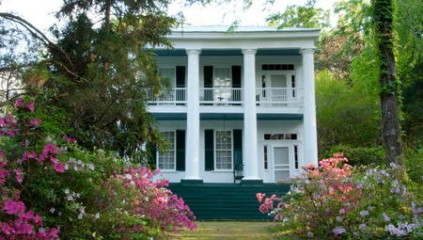Myrtle Hill
$289,000 Withdrawn
Withdrawn



Property Details
303 W Lafayette, Marion, Alabama 36756
Description:
C.1840 Myrtle Hill, built by John Huntington, son of Roswell Huntington, silversmiths from North Carolina. This 2-story Greek Revival style home has 5 bedrooms, 3.5 baths, original kitchen building and carriage house, and acres of gardens beautiful in every season! $289,000. Call Kay! Myrtle Hill History: Myrtle Hill (Circa 1840) is one of four antebellum homes built side by side on this street by John Huntington, son of revolution war soldier, Roswell Huntington. The Huntingtons were gold and silversmiths by trade. The other three homes are the two on your right and the Greek Revival cottage on your left as you face Myrtle Hill. The construction of the home is Greek Revival style, a predominate style of the West Marion Historic District. Four Doric columns support the portico of the home. Across the front there is a double veranda with tall shuttered windows. The side hall entry resembles designs expected to be seen on small lots in cities such as Charleston. Like many old homes, additions have been made. The first floor east wing was added in the 1850?s and an inside kitchen in the early 1900?s. On display in the kitchen is the first electric stove in Marion. The original carriage house and detached service kitchen and slave quarter located in the rear of the home have been restored. William Foster, a slave broker from North Carolina, purchased the house for $3,000 in 1841 during a visit to Alabama from North Carolina but never had a chance to live in it. He came to an untimely death at the hands of his own slaves at some point where he had camped in the state of Georgia during his return to Alabama. An administrator of the estate rented the house for 14 years until a prayer was filed in the Perry County Court requesting settlement of the estate in the best interest of the children of tender age. In 1855 the home was purchased by George Doherty Johnston for only $2,005, since it was in a dilapidated condition. Johnston received his AB & MA degrees from Howard College (Marion Military Institute) in 1849 followed by his law degree from Cumberland University in Tennessee. He began his practice in Marion, Alabama with Judge John T. Vary, his next door neighbor. Johnston served as mayor of Marion in 1856 and as a member of the Alabama Legislature in 1857 & 1858. He was the first to enlist from Marion in the Confederate States Army as a Second Lieutenant, Company C, 4th Alabama Regiment. He fought in numerous battles and was present at every engagement of the Army of Tennessee, from Shiloh to Bentonville. He rose in rank to Brigadier General. On July 28, 1864, two days after he was promoted to General, he was severely wounded at the Battle of Ezra Church, Georgia. After the war, General Johnston returned to Marion and rejoined in the practice of law with his partner John Vary. In 1871 he was appointed and served for several years as Commandant of Cadets at the University of Alabama. From 1885 to 1890 he served as the Superintendant of the South Carolina Military Academy (The Citadel). After leaving The Citadel, he returned to Tuscaloosa, Alabama to again resume the practice of law. In 1892 he was appointed the United States Civil Service Commissioner during President Cleveland?s second term. After returning to Alabama, he was elected to the Alabama State Senate. He died in 1910. In 1907 the home was purchased by Mr. and Mrs. William M. Caffee, the parents of Mrs. Paul Lovelace (Miss Ruby) who viewed it as a shrine to the Old South. When little Ruby first saw the house, she wanted her parents to name it Myrtle Hill because the crape myrtle trees on the property were in full blossom. Miss Ruby often spoke about ?the war,? meaning the Civil War. Two of her prized possessions were antique reliefs of Robert E. Lee and Stonewall Jackson which the family gave to the Lewises when the house was sold to them in 1989. Miss Ruby was 95 at the time and lived to be 106. Surrounded by acres of beautiful gardens, Myrtle Hill is listed on the National Register of Historic Places. Elegantly furnished with 18th and 19th century antiques, the five bedroom home displays two palace-size 1800?s gold gilt mirrors and an 18th century king size bed that belonged to Baron de Graffenried, who founded New Bern, North Carolina. The gardens feature many varieties of azaleas, hydrangeas, camellias, seasonal flowers and water garden with beautiful waterfall. The Lewises did a complete restoration on the home and opened in April 1994 as Myrtle Hill Bed and Breakfast & Gardens.